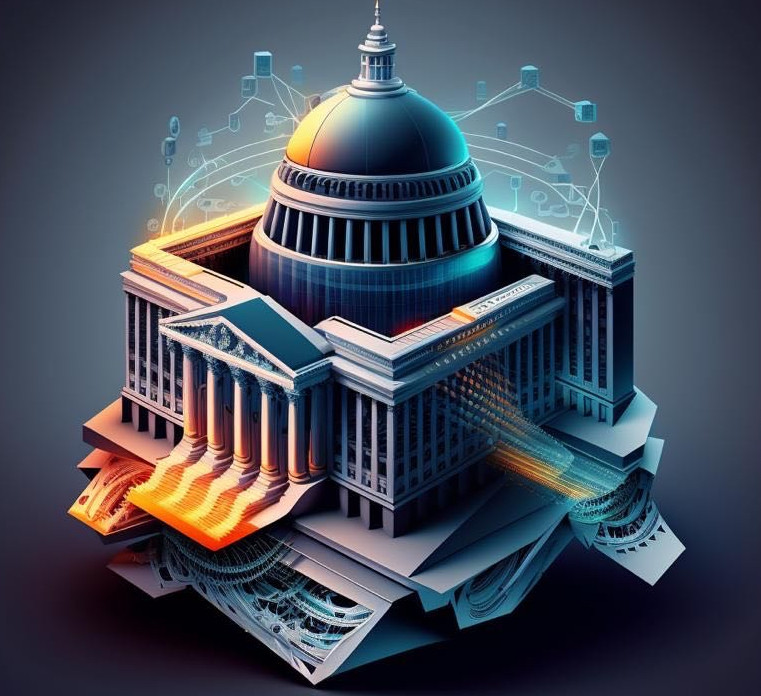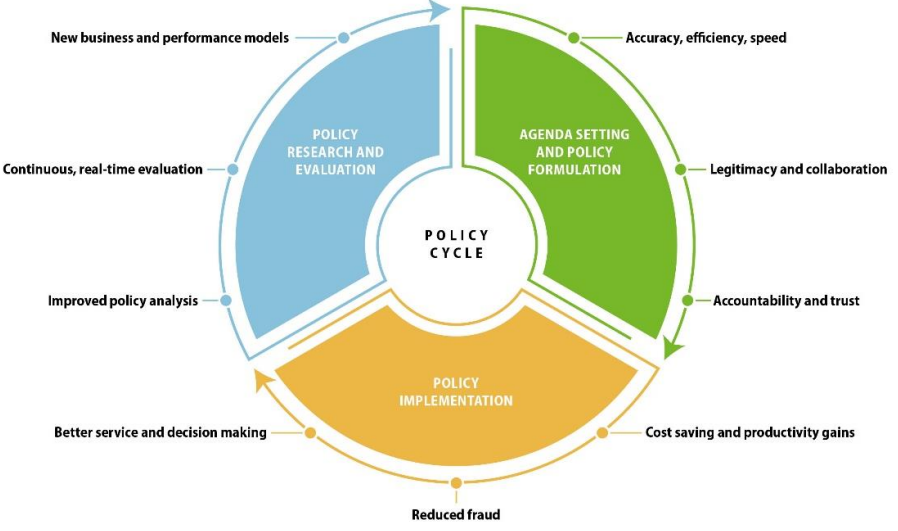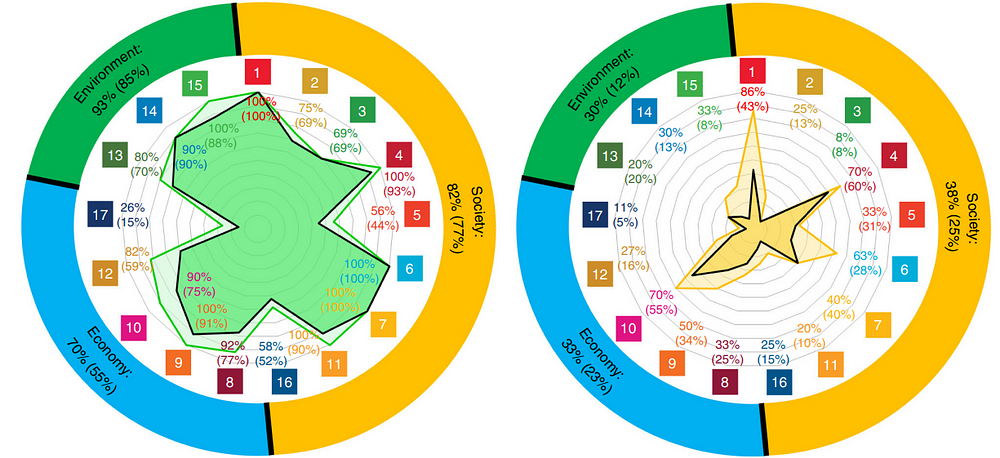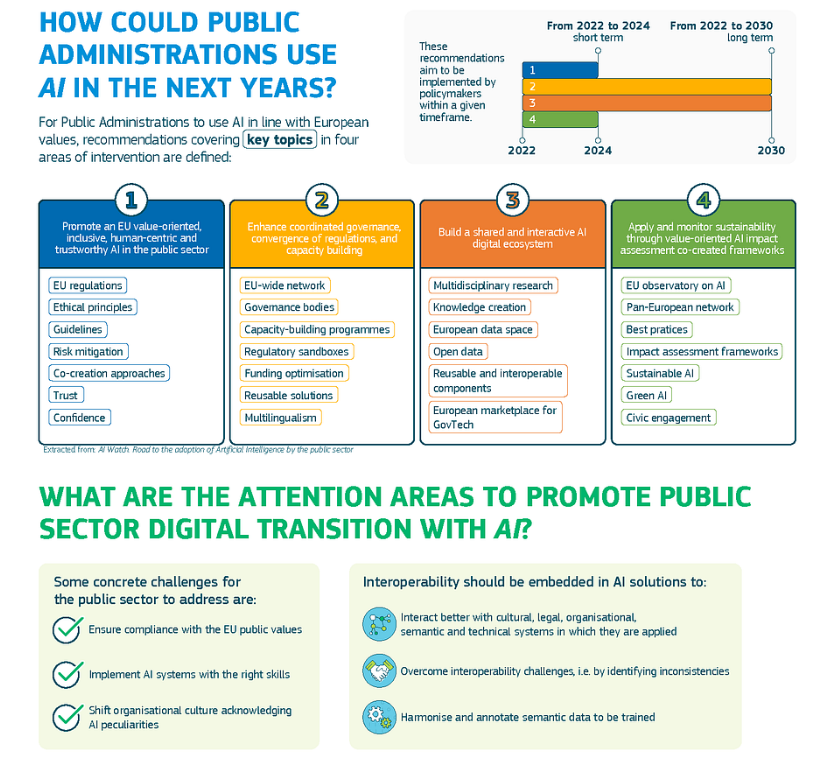Strategy to Success: AI in Public Sector
Artificial intelligence (AI) applications help make more accurate decisions, effectively plan resources, detect fraud, identify and reduce security risks, and map the unmet needs of citizens by finding patterns and irregularities in the data. Accurate and high-quality data can help design these capabilities of AI to design the ongoing policy cycle from social analytics, agenda setting and policy formulation to implementation and improvement.
Figure 1. Promising preparation of the public sector for AI

Source: Image generated by AI using Midjourney
The public sector plays a critical role in the functioning of modern societies, and its effectiveness is closely related to the quality and availability of data. In recent years, advances in data technologies, such as AI and big data, have allowed the public sector to harness the power of data to improve service delivery and make more reliable and responsible decisions. Integrating AI, digital twin (DT) and Metaverse technologies, directly fed by data into the public sector, can potentially revolutionize how governments work and interact with citizens. The effects of advanced data technologies on governments’ strategies and economies will likely be significant. Governments can increase the efficiency and effectiveness of their operations by leveraging data to make more effective decisions and develop policies. Additionally, by using AI technology, governments can create new revenue streams, attract new businesses, and increase the overall competitiveness of their economies.
Figure 2. Leverage of AI in three key phases of the policy cycle

Good Practices
Increasing efficiency and productivity is very important for states. AI emerges as an important auxiliary tool for the public sector to automate time-consuming and human error-prone tasks, and to reduce errors.
For example, since January, the Internal Revenue Service (IRS) has used voice bots on multiple lines to promptly respond to direct payment or notification inquiries from taxpayers. The voice bots have now answered more than three million calls. In 2022, the IRS planned to introduce additional upgrades to its voice bot service to allow taxpayers with established or new PINs to retrieve their accounts and return transcripts, payment history, and the current balance owed.
AI tools developed for earthquakes, floods and extreme weather conditions are an area that quickly finds a response in the public sector for public health and safety. For example, the National Weather Service can significantly protect the public from severe weather events by using AI to improve weather forecasts and warning systems. Another critical example is that during the massive earthquakes in Türkiye and Syria on February 6, 2023, we witnessed that both public institutions and software-oriented NGOs carried out essential studies that support the effective distribution of aid through data analysis. To address crises, open-source relief websites and platforms are being developed, and some have received startup funding. These initiatives aim to assist in various ways, such as creating heat maps to locate survivors buried under debris based on information collected from distress calls. Other efforts include providing information about blood donation, linking temporary accommodation providers and food/clothing distributors, and compiling lists of individuals needing urgent medical or humanitarian attention, created using AI to sort through scattered data. Furthermore, apps are available to connect volunteers with those who require help.
AI integration into healthcare applications in the public sector is another notable use case. The Centers for Medicare and Medicaid Services (CMS) utilize AI to examine data on healthcare demands, extract knowledge of care trends, and recognize potential fraud or misuse of resources.
The US Government Department of Defense has focused on analyzing and classifying satellite images with AI-based tools. This allows analysts to focus on more complex tasks.
AI can also find a place in the public sector to save costs. The most important examples are taxes, social security and services, and manufacturing and energy industries. The importance of utilizing AI to manage constraints, uncertainties and risks in the supply, production and energy sectors has been well understood, especially due to the pandemics and wars that have impacted the world in the last few years. To this end, the US Department of Energy has established an Artificial Intelligence and Technology Office.
On the other hand, there is a need for experts who will develop AI technologies and decision-makers with a high level of awareness. Therefore, training and skill development programs for AI are increasing day by day. In 2018, the French government adopted a new national strategy called “National Strategy Against the Digital Divide” to help citizens and residents gain digital literacy, skills and autonomy. As part of this strategy, the government launched the Digital Pass program, which provides free training in digital technologies. Governments worldwide are also taking steps to increase the skills of their public workforce. For example, the French Institute for Public Management and Economic Development offers various training courses, including “Digital transformation of the state and data” and “AI, data science: New economic challenges,” to equip public servants with basic knowledge about AI and its opportunities and challenges.
Data to Policy Navigator, a very new toolkit developed by the United Nations Development Programme (UNDP) for policymakers in the public sector, aims to pave the way for utilizing data and data-driven technologies, such as AI, to solve complex policy problems.
Challenges
There are undeniable benefits to using AI technologies in many areas, including the public sector. However, the use of AI brings along also significant difficulties.
First of all, it is a costly investment. The infrastructure and cloud investments required to collect data, improve its quality, and securely store, process and share this data need major investment budgets. This constraint can be a challenge for developing countries.
Globally, the most critical challenge is the need for more technical expertise; that is, the limited human resources with the qualifications to develop AI technologies. There is serious competition between countries in this regard, which can be observed on brain drain maps.
Specifically, the difficulty in implementing AI in public institutions arises because current legislation and regulations must adequately cover AI technologies and data-related dynamics. It is essential to follow ethical codes to ensure data privacy and security, and reduce discrimination and prejudice in data and systems. It is necessary to inform the public about AI technologies, to process data, and to carry out awareness-raising studies about the gains. On the other hand, it is necessary to focus on the legal regulations regarding all these difficulties.
The EU AI Act deals with legal regulations with a risk-based approach. The law establishes a set of requirements and prohibitions for high-risk AI systems. These requirements include mandatory risk assessments and conformity assessments, as well as requirements such as transparency, human auditing, and data quality. The legislation also prohibits certain AI practices that are deemed unacceptable, such as manipulating people’s behavior or creating deepfakes without explanation. This act is designed to encourage the development and distribution of reliable and secure AI systems that are beneficial to society, at the same time ensuring that the fundamental rights of individuals are protected.
The Position of AI in the Sustainable Development Goals
The growing influence of AI in various fields has made it questionable to assess its impact on achieving the Sustainable Development Goals (SDGs). A valuable study on this subject has been published in Nature Communications. In this study, it was discovered, through a consensus-based expert identification process, that AI has the potential to facilitate the achievement of 134 goals across all SDGs but can also inhibit 59 goals. However, current research needs to include more critical areas. To ensure that AI-based technologies contribute to sustainable development, adequate regulatory insight and oversight must be provided to accommodate the rapid advancement of AI. Failure to do so may result in deficiencies in ethical standards, security, and transparency. The figure presented below summarizes this work.

The positive and negative impact of AI on the various SDGs Source: Vinuesa, R., Azizpour, H., Leite, I., Balaam, M., Dignum, V., Domisch, S., Felländer, A., Langhans, S. D., Tegmark, M., & Fuso Nerini, F. (2020). The role of artificial intelligence
The figure presents documented evidence on how AI can enable or inhibit progress toward achieving each SDG. The colored squares represent SDGs, and the numbers inside them correspond to each goal. The percentages on the top indicate the proportion of all targets that AI could impact, and the ones in the inner circle of the figure represent the proportions within each SDG. The outer circle of the figure shows the results for the three main SDG groups: Society, Economy, and Environment. The inner shaded area represents the results obtained when the type of evidence is considered, with the values in brackets indicating the specific values for each group.
Conclusion
AI significantly contributes to countries and the world by helping develop policies, improve processes and reduce costs, which is horizontally reflected in many sectors, but especially in public benefit and the public sector. I believe that increasing this daily contribution, cooperation with the private sector and universities, and harmonizing international ethical norms and legal regulations will enable us to solve many crises, such as economic, energy, and climate, that we are grappling with globally. This inspiring infographic summarizes the EU's ethical and human-centered approach to key topics, impacts, and short-term and long-term public sector use. For the entire infographic, I recommend checking out the source.
Figure 4. To promote digital transformation with AI in the public sector in line with European values

Source: ELISE–European Location Interoperability Solutions for e-Government, Infographic – Artificial Intelligence in the Public Sector
